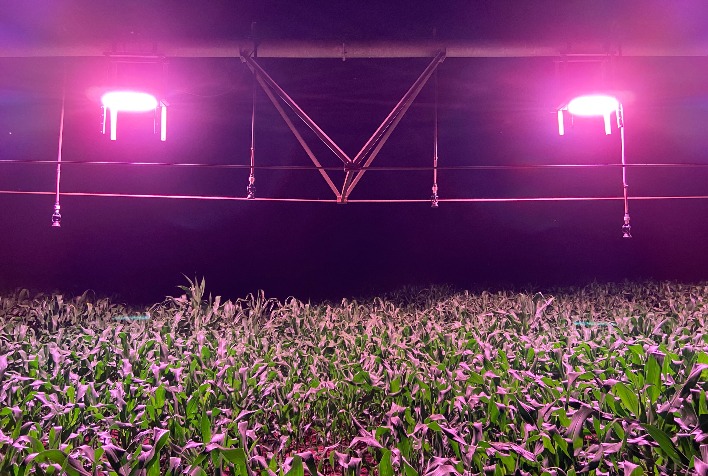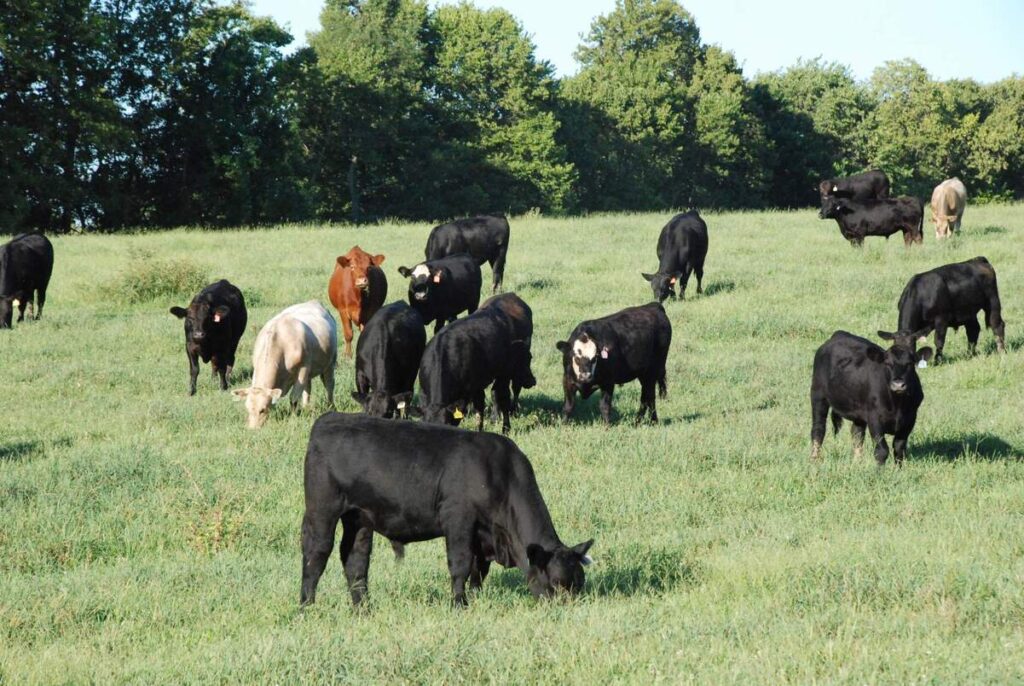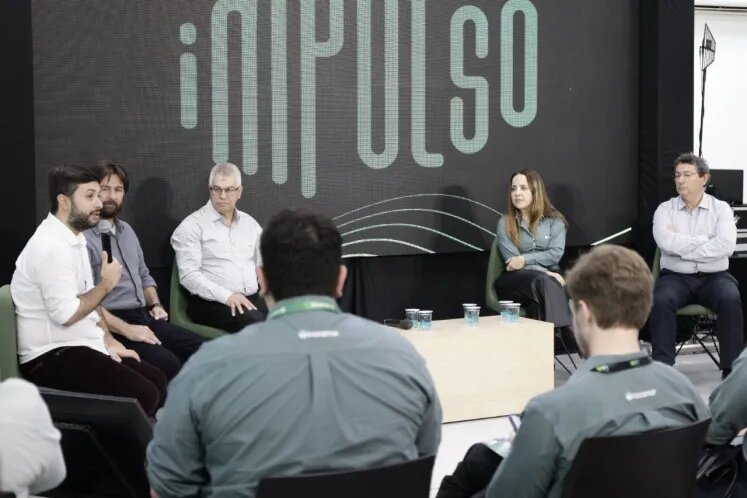Continuing the article by researcher and knight Luciano Ferreira Rodrigues Filho (If you haven’t seen it, click here), today he brings all the methodology used to carry out the research and the results obtained. Check out!
Methodology
The methodology adopted for the development of the Revision of the Study of the Complexo do Agronegócio do Cavalo report was based on analysis of secondary data, bibliographic review and interviews with professionals and specialists in the area.
Initially, data and information available in public databases, such as IBGE, the Ministry of Agriculture, Livestock and Supply (MAPA) and the Agricultural Information System (SIAGRO), were collected and analyzed in order to understand the current situation of the sector.
Then, bibliographical reviews of studies and scientific articles that address the theme of equine farming in Brazil and in the world were carried out, seeking information on trends, challenges and opportunities in the sector.
In addition, interviews were conducted with professionals and specialists in the field, such as horse breeders, veterinarians, representatives of industry entities, researchers and university professors. These interviews were carried out in person or virtually, and sought to gather additional information about the reality of the sector, as well as opinions and suggestions for the development of the horse agribusiness.
Based on these data and information, the report for the Revision of the Study of the Complexo do Agronegócio do Cavalo was prepared, which presents a current overview of the sector in Brazil, challenges and opportunities for the development of horse breeding, in addition to pointing out measures for the promotion of agribusiness. of the horse in the country.
These data were crossed with data from the 2017 Agricultural Census presented by the IBGE and with the Municipal Livestock Survey (2020), on the estimate of the number of horses in each state of Brazil.
some results
Regarding the herd of horses, we can see that the number of these animals fluctuated between 2016 and 2020, showing a gradual growth over the period, from 5,576,136 in 2016 to 5,959,922 in 2020. This suggests that the equine market may be expanding in Brazil. This can be seen in the valuation of horses during the pandemic period.
It is not possible to say with certainty whether there was an increase in the equine herd during the pandemic, as the most recent data available are from 2020 and do not provide specific information about the period of the pandemic. However, it is possible to raise some hypotheses about possible factors that may have influenced horse breeding during the pandemic:
– Greater demand for outdoor activities: With the closure of public spaces and the need for social distancing, people sought more outdoor activities and contact with nature. Riding could be one such activity, which could have boosted the demand for horses and, consequently, the growth of the herd.
– Change in consumer profile: With social isolation and the need to work at home, many people may have chosen to live in regions further away from large urban centers. This change in consumer profile may have generated an increase in demand for rural activities, including horse breeding.
– Increased demand for natural products: The pandemic may have encouraged greater concern about health and the origin of food. In this context, the production of meat and milk from horses, for example, may have benefited, boosting herd growth.
According to the Review of the Study of the Horse Agribusiness Complex, the distribution of the equine herd is divided into two categories: animals destined for sport, leisure and breeding and animals destined for handling (work).
According to the report, the number of animals destined for sport, leisure and breeding is 1,100,000, while the number of animals destined for handling is 3,900,000. The total number of equine animals on the property is 5,000,000.
These data can be useful to understand the use of horses in the context of rural property. The fact that there is a significant amount of animals intended for sport, leisure and breeding suggests that there is a demand for this purpose in the market. The greater number of animals intended for handling indicates that the use of these animals for productive activities is still predominant.
In addition, the table may indicate the importance of knowledge about the purpose of raising horses for the management of rural property. This is because the purpose of breeding can influence various aspects of animal management, such as nutrition, training and health, among others.
This estimate states that 22% of the herd is destined for sport, leisure and breeding and that 78% for livestock (work). Following this estimate, we can suggest the national herd, according to the herd of each state, as follows:
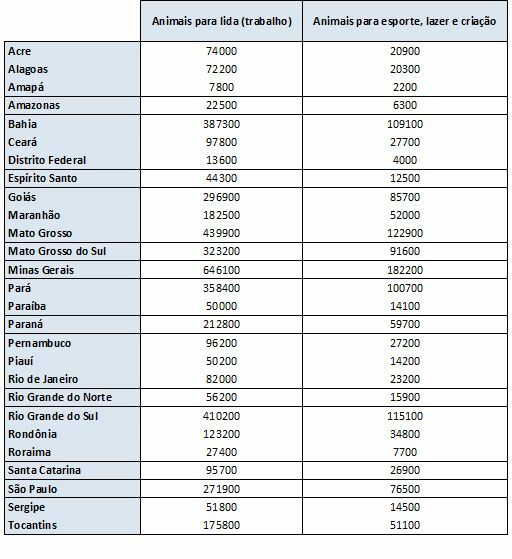
Thus, the data presented indicate that the Complexo do Agronegócio do Cavalo in Brazil generated a total income of R$ 16.15 billion in April 2015. This amount was distributed among different segments, such as Lida, Sport and Leisure, PSI and Turf and Others.
The Lida segment contributed the most to the complex’s income, with R$ 8.58 billion (53.13%), followed by Sport and Leisure, with R$ 5.84 billion (36.13%). PSI and Turf and Others had a smaller contribution, with R$ 0.79 billion (4.89%) and R$ 0.94 billion (5.81%), respectively.
In addition, the table shows the number of people employed in each segment. The Lida segment was also the one that employed the most people, with 433,333 direct occupations (71.37%), followed by Sport and Leisure, with 125,700 direct occupations (20.71%). PSI and Turfe and Others had a smaller number of employed persons, with 5,452 (0.90%) and 42,844 (7.02%), respectively.
The text also highlights that the Complexo do Agribusiness do Cavalo directly employs 607,329 people. Furthermore, considering that each direct occupation provides four other indirect occupations, it is estimated that 2,429,316 indirect jobs are generated. Thus, the Complex is responsible, directly and indirectly, for 3 million employed persons.
In this way, with these estimates of economic contribution, one can have an overview of each state in the country in the horse agribusiness complex referring to the categories Animals for handling (work) and Animals for sport, leisure and breeding, for this estimate were not including the figures for PSI and turf and Others, which represent a slice of 790.0 million and 940.0 million respectively. They were not increased due to the impossibility of determining these values in each State, with many negotiations, such as auctions, with buyers and sellers from different States of the country.
The following table shows the values in reais (R$) spent on animals for sport, leisure and breeding in each state of Brazil, in addition to the total spent across the country. The state of Minas Gerais leads the list with BRL 806,708,112.21, followed by Mato Grosso and Rio Grande do Sul. The state of Amapá had the lowest expenditure, with R$ 9,740,712.66. In total, the country spent R$ 5,840,000,000.00.
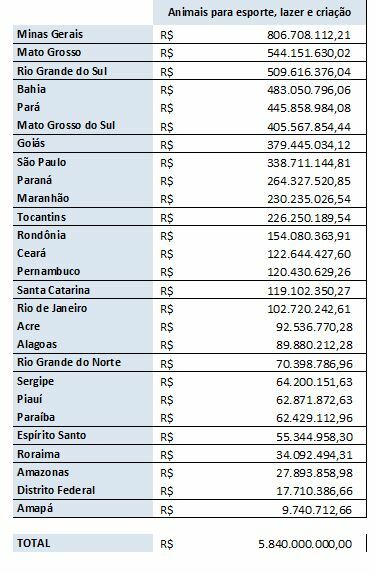
The table below shows the amounts in reais (R$) spent on animals for work (lida) in each state of Brazil, in addition to the total spent across the country. The state of Minas Gerais again leads the list with R$ 1,187,078,524.17, followed by Mato Grosso and Rio Grande do Sul. The state of Amapá had the lowest expenditure again, with R$ 14,330,927.86. In total, the country spent BRL 8,580,000,000.00 on working animals. It is noted that the amount spent on animals for handling is higher than the amount spent on animals for sport, leisure and breeding, evidencing the importance of animals in the country’s productive activity.
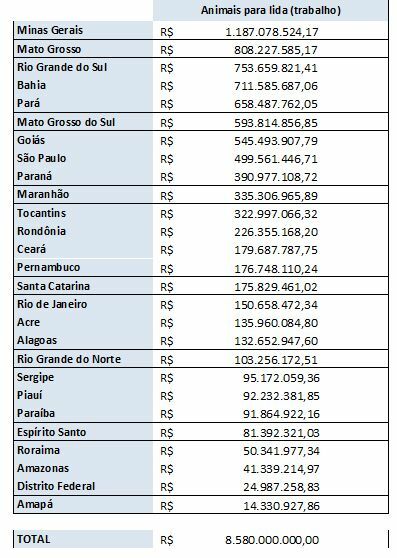
Final considerations
Equine farming is an important economic activity in Brazil, with great potential to generate jobs and income in different regions of the country. The diversity of horse breeds and their specific aptitudes, combined with the demand for sports, recreational and therapeutic activities, make equine farming an industry in constant growth.
For equine farming to continue to grow and develop, it is essential to encourage the modernization and professionalization of the horse industry in the country. This includes investments in research, technology and infrastructure, as well as the training of specialized professionals in different areas related to horse breeding. In addition, it is essential to adopt good animal husbandry and management practices, ensuring the well-being of the horses and the quality of the products and services offered.
Therefore, equine farming represents a great opportunity for the development of agribusiness in Brazil, generating jobs and wealth for the country. However, a joint effort by governments, producers and professionals in the field is needed to ensure that the horse industry continues to grow in a sustainable way, promoting animal welfare and the country’s economic development.
References
IBGE. Municipal Livestock Research. Available at: https://sidra.ibge.gov.br. Accessed on: March 18, 2022.
MAP. Ministry of Agriculture, Livestock and Supply. Review of the Horse Agribusiness Complex Study. Brasília: MAPA, 2016.
By Luciano Ferreira Rodrigues Filho, Knight and Researcher | Haras Dom Herculano
Photos: Reproduction/ Pixabay
Read more articles here.

